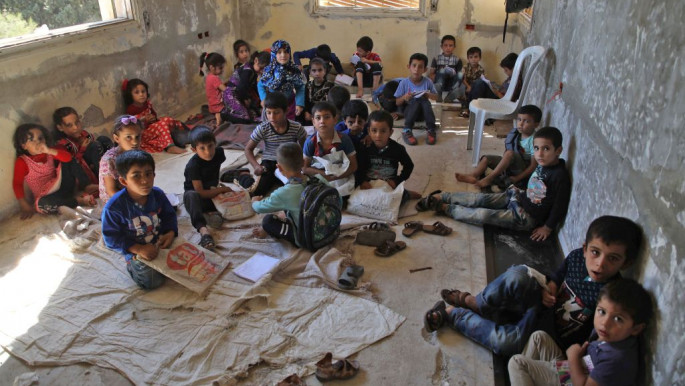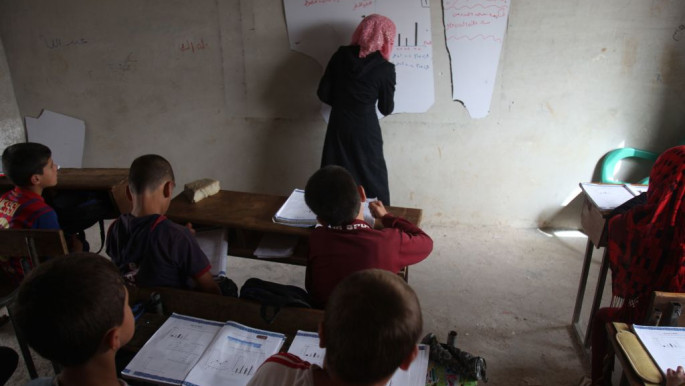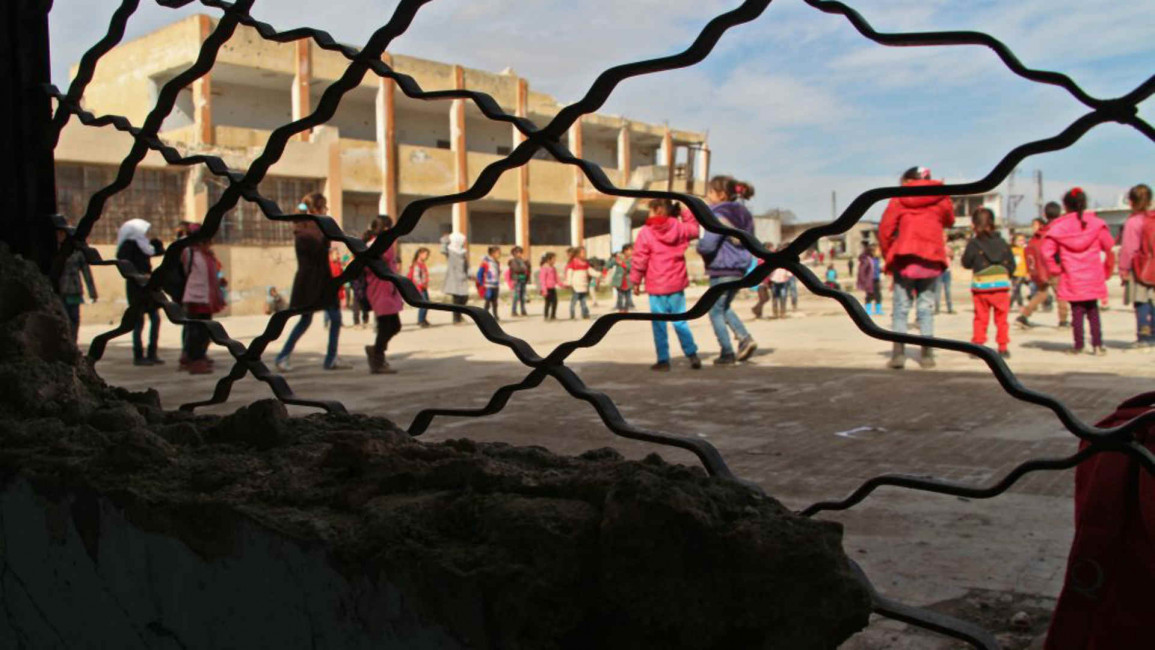
Syria: A wrecked school system, a country in ruins
If we are to believe Unicef statistics, the rate of primary school enrolment in 2011 was 99.6 percent for any given age group, and was practically equivalent for girls and boys.
At secondary level, it was 58 percent with only a slight advantage for boys. And finally, while illiteracy was not entirely eliminated, the literacy rate among adults was 84 percent, and 95 percent for young adults from 18-25.
These seemingly remarkable figures must, however, be taken with a grain of salt, both quantitatively and qualitatively.
"We came to realise that we did not really know our society," says Sahar, an activist in Damascus.
When she and her friends decided to help families fleeing the bombs of the regime across the country, they discovered the true extent of illiteracy, as well as practices they thought had been eliminated. These included child marriage, which the general violence and disappearance of fathers has made worse, but also considerable numbers of children whose births were not officially registered and are therefore not enrolled in any school.
Not only were the material conditions woefully deficient but the educational methods were authoritarian with a emphasis on learning by heart, and the inculcation of obedience to authority through "patriotic education" ("tarbiya wataninyya") which has developed a servile devotion to the nation and the state, and an abstract and passive relationship to knowledge.
 |
The government still insists on guarding the curricula against any attempt to introduce 'subversive ideas', be they religious or cultural |  |
Over the last few decades, unbridled population growth had given rise to seriously overcrowded classrooms. Private lessons had flourished and profit-making educational institutions emerged to provide support for pupils of primary and secondary public schools, often ensured by the staff of those same schools.
Today, when nearly a third of the population is in exile and almost as many have fled their homes for another part of the country, nearly half the children are out of school.
In 2015, according to a report by the UN Secretary-General, the Syrian Ministry of Education admitted that "since the beginning of the conflict, more than 6,500 schools have been destroyed, partially damaged, used as shelters for internally displaced persons or rendered otherwise inaccessible."
According to a Unicef report for 2016, "Syria counts 2.1 million school-age children (5-17) who are not in school. Moreover, 600,000 Syrian refugee children scattered throughout the region are also deprived of an education."
Displaced two, three, four times
In the areas controlled by the rebels, neither of the schools, hospitals or public buildings have been spared; in fact they have often been targeted by the bombings.
In the areas still controlled by Damascus, while many school buildings were made available to needy displaced persons for varying periods, public schools that are still functioning have seen the size of classes double or triple, not to mention the predicament of exiles in neighbouring countries or refugee camps.
 |
|
| Displaced Syrian children attend class at a makeshift school in the village of Muhandiseen, in the south western countryside of the Aleppo province [AFP] |
In practice, for the thousands of children whose families have been forced to move house two, three or four times - sometimes even more - it means either an interruption in their schooling or a delay of several years before it can even begin. And as time goes by, the children from areas abandoned by the public service and who are no longer listed in the civil registry, if they ever were, add to the number of out-of-school children.
Nayla, a teacher from Idlib I met with in Damascus early in December 2018 told me about the arrival of the Al-Nusra Front in 2015.
She told of how its fighters had forced women to dress according to supposedly "Islamic" norms, hunting down those whose clothing showed a bit of ankle; how "kids" separated the women from their husbands in collective taxis, making the men sit on the front seats and the women in back; how they accused civil servants, and especially the teachers, of being "shabiha" (members of the government's militia); how they changed their teaching curriculum.
Good conduct overseers
She also recounted that when "the coalition" took control of the city, women known as "murchidates" (good conduct overseers) were sent into the schools to supervise the way the girls were dressed.
One incident caused a great stir around town: During an exam, one of these murchidates tried to force a girl to leave the room because she felt she was incorrectly dressed. The other pupils stood up for their classmate until her father arrived in a rage and forced the so-called educator to leave the pupils alone.
 |
Public schools that are still functioning have seen the size of classes double or triple |  |
However, Nayla went on, whereas the Al-Nusra Front had imposed its own school curricula by doing away with philosophy classes, replaced by religious teaching, when the schools came under the control of the coalition the official curriculum was restored, merely purged of its political content and the cult of the Assad family. And in 2018, there was even one school where the personnel was still being paid by the central government and which continued to use the official curriculum in its entirety.
Actually, in a certain number of regions which the regime has ceased to control since 2012, the teachers who remained on the job went on receiving their pay for varying periods of time. Despite material hardships, the schools were still in operation, following the official curriculum minus a few courses like "patriotic education" or "social studies".
Indeed, the teachers' main concern was enabling pupils to prepare for the exams which would earn them officially recognised diplomas. In Aleppo, the regional council had taken over the educational system, restored many school buildings and paid teachers' salaries. They also followed the official programmes, eliminating the political education courses but introducing new artistic activities and training teachers in new educational methods.
 |
|
|
Since the beginning of the conflict, more than 6,500 schools have been destroyed or partially damaged [AFP] |
Regions administered by the Kurdish Democratic Union Party represent a special case: The autonomous administration has set up a teaching programme in Kurdish, while maintaining classes in their own language for Arabic-speaking pupils and creating specific classes for the tiny minority whose language is Syriac.
The curricula have been completely revised in keeping with the political project of the new leadership.
In the regions which have remained in the bosom of the regime or returned to it, all children must officially be able to attend public school. However the extent of internal displacement has caused servere overcrowding of classrooms and a deterioration of the children's material environment.
Classes can be 40, 50, sometimes as many as 60 pupils, even after a second section has been opened, with morning and afternoon sessions. Nonetheless, here and there we are told the pressure has eased due to the return home of displaced families.
 |
The Al-Nusra Front had imposed its own school curricula by doing away with philosophy classes, replaced by religious teaching |  |
In Nanyas, Hanaa, a primary school teacher, reports that class sizes have risen from 30 to 40 or 50 pupils as a result of the influx of displaced families, often having fled Aleppo after 2012.
Many of those in the Sunni districts were able to flee the Spring massacre of 2013, but the schools they left behind were destroyed. However since Aleppo was recaptured, she tells us, a number of families have now returned to their villages and their districts, easing the pressure in Nanyas.
An absolute priority
According to her friend Sorayya, the overcrowding is sometimes made worse by the parents' reluctance to accept the splitting of the classes; they want their children all to be on the same schedule. In Banyas, most of the schools appear to have given up that solution, while another witness reports that in Lattakia the school authority set up morning and afternoon sessions, gave up, and then restored them.
Confronted with this situation, Syrians, needless to say, have not been sitting by, and waiting for international organisations, intergovernmental agencies or NGOs to come to the rescue. "This is an absolute priority," says Souheir, "if we leave those kids hanging around in the streets they can become delinquent or be recruited by the terrorists."
Twitter Post
|
In response, the population relies primarily on local resources, volunteer initiatives, material support from community leaders and various existing structures, but also material and financial aid from other countries, sometimes from nearby Lebanon, Catholic charities, and associations of various sizes via ad hoc local relays.
However, the law forbids receiving foreign aid without government authorisation. Whatever its ethnic identity, its political or religious orientation, every school involved in these initiatives must find ways around the obligation to submit to the control of the Ministry of Education.
Thus, this statement by Nabil Antaki, a physician who took part in the founding of the Maristes bleus who have taken charge of thousands of displaced persons from East Aleppo, echoes the strategy of other activists in Lattakia or Damascus: "What we are doing here is illegal... So we play with words, we never speak of a school, only of 'a project'."
In Lattakia, where until now the only pre-school educational structures were fee-paying private tuition, charities have set up two nursery schools meant specifically for children of displaced families. Unfortunately, their limited resources do not allow them to satisfy the demand, the people in charge regretfully explain.
One of them is run by activists who decided to operate in keeping with officialdom, thus making it possible for them legally to receive foreign aid and pay wages, but obliging them to submit to stringent official surveillance.
The other refuses to depend either on governmental control or help from foreign donors and hence has greater freedom, but fewer resources: It mainly relies on a voluntary workforce and on its ties with groups of exiles who manage to send them small amounts of aid through unofficial channels. In so doing they are outside the law, and know they are running a risk.
In the suburbs of Damascus, Umm Wassim, who began by working with the Syrian Red Crescent, and then, by using that as a cover, managed to open a shelter for displaced children within, and with the help of a private school.
 |
Not only were the material conditions woefully deficient but the educational methods were authoritarian |  |
Two types of activities happen there: In the evening children who need to make up for lost time in basic subjects (Arabic, English, maths) are schooled; and during the daytime classes are for children who have been denied schooling for lack of any ID.
Finally on Saturdays, extracurricular activities are organised which are open to all, and which include physical self-expression sessions designed to alleviate accumulated stress.
Activities for pre-school children are meant both to help them overcome the traumas they have experienced and prepare them for primary school.
But in Lattakia and in Banyas, like in the suburbs of Damascus, activists all emphasise that overcrowding in primary classes is likely to cancel out the benefit of of these efforts once children arrive in the official schools, despite the aid supplied by Unicef.
Development of the private sector
To what extent will the failings of public education favour the development of a private sector, confessional or for-profit, which was already in full swing before the uprising began 2011?
Knowing that 80 percent of Syrians live below the poverty line, it is obvious that only a minority would be concerned by its development, which widens the gap between a tiny elite of privileged citizens and the masses.
In Salamiyah, I am told of a growing number of 'institutes' which offer complimentary evening classes for groups of 20 pupils, often taught by teachers from the public school system, who are topping up their monthly wages or pensions. Rafiq, a retired science teacher, has classes in three of these private institutes and explains to me that these existed long before 2011.
 |
Every school involved in these initiatives must find ways around the obligation to submit to the control of the Ministry of Education |  |
Even though, as several people told me, the obligation to hold classes in "patriotic education", "national culture" and other "social studies" has grown less stringent since pre-2011 times, the government still insists on guarding the curricula against any attempt to introduce "subversive ideas", be they religious or cultural.
UNICEF, whose official partner is still the state, has contributed to the "modernisation" of the curricula in order to help pupils catch up on lost ground and more generally to rethink the whole school syllabus.
However the curricula under elaboration are the object of debates and controversies which are likely to water down the teaching content even more.
History, geography, and civic instruction are not the only matters at stake here; literature as well can come under fire, since an author praised by the opposition will be seen as anathema by the powers that be, while an image of a veiled woman or a bearded man used to illustrate a textbook will be seen as Islamist propaganda.
And, of course, the language used in class is equally an issue. It is out of the question to offer Kurdish or any other minority language, not even as an option.
Read more: Syria regime evicts thousands from battle-scarred Aleppo, following deadly building collapse
On the other hand, the minister has started to bring Russian into secondary schools. To what extent will Russian or Iranian advisers be taking part?
In its editions of last 23 January and 5 March, the Syria Report refers to the development of relations with these two countries in the area of education.
Iran is said to have already opened many schools in Damascus, Lattakia and in Eastern Syria. On the other hand, the region administered by the Kurdish Democratic Forces is currently setting up a 'national' educational system which is repeating the defects of the Baath system from the ideological standpoint.
 |
The minister has started to bring Russian into secondary schools |  |
Revolutionary political instruction and the cult of the personality of Abdullah Öçalan aroused the hostility of part of the region's population, especially among non-Kurds. In the 2,400 new schools, only the final years follow the Syrian curriculum. For the others, the old textbooks are banned.
Like the reconstruction of the country itself, that of the school system is likely to take a long time and may well be an impossible dream.
Far from reflecting a "healthier and more homogenous society" - which Assad claims to be in the offing - the school system which Syria is preparing to build will long be confined to turning out a mass of unqualified workers for a totally deregulated market, alongside a minority of poorly qualified college graduates reduced to silence and, at best, a tiny elite with no choice but to emigrate or wheel and deal in a borderless, globalised world.
Even if a few experiments are still being carried out by activists or pedagogues concerned to form open-minded citizens, one can only fear that their efforts will be nullified by a regime whose only goal is to maintain its rule whatever the cost.
This article was originally published by our partners at Orient XXI.
Join the conversation: @The_NewArab
Opinions expressed in this article remain those of the author and do not necessarily represent those of The New Arab, its editorial board or staff.


![President Pezeshkian has denounced Israel's attacks on Lebanon [Getty]](/sites/default/files/styles/image_684x385/public/2173482924.jpeg?h=a5f2f23a&itok=q3evVtko)



 Follow the Middle East's top stories in English at The New Arab on Google News
Follow the Middle East's top stories in English at The New Arab on Google News


